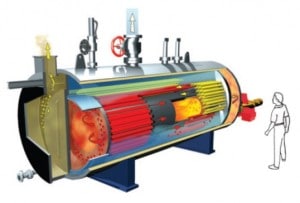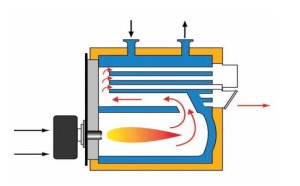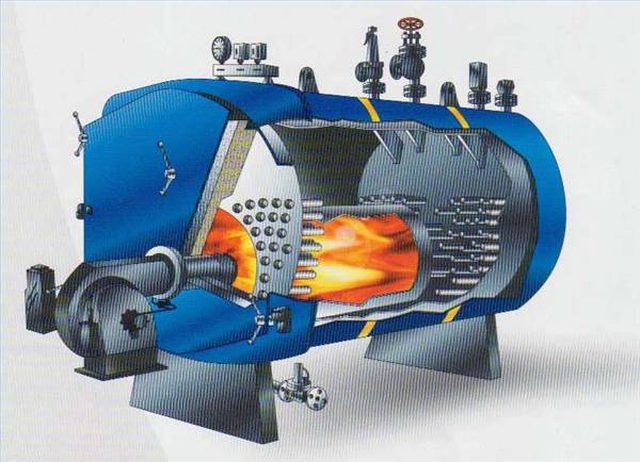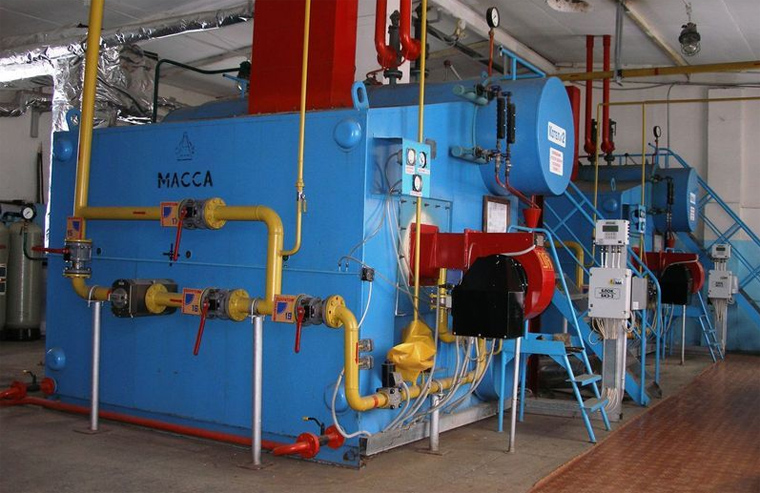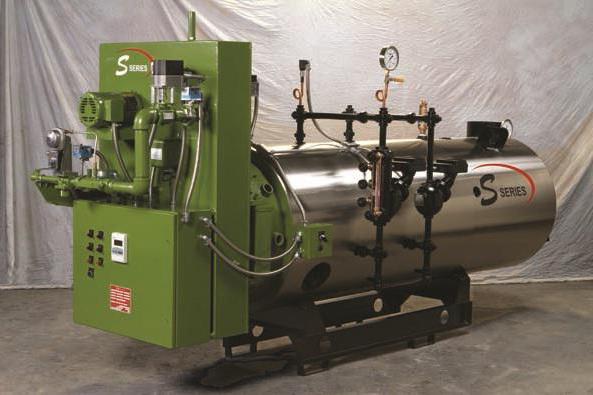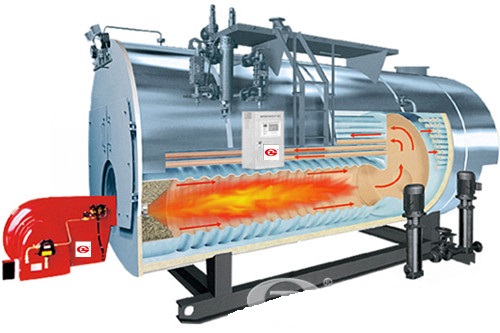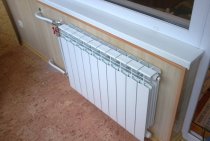Materials for the manufacture of chimneys for condensing boilers
The two most common materials used for condensing boiler chimneys are flame retardant polypropylene and stainless steel.
Flame Retardant Polypropylene (PPs)
In domestic use, PPs chimneys are the most affordable and convenient in terms of installation. Generally speaking, polypropylene chimneys are also used with traditional boilers of the most modern designs, but still the service life in this case is limited due to the relatively high temperature of the flue gases.
In the case of condensing boilers, the exhaust temperature is low enough to have no effect on the strength of the chimneys. In addition, polypropylene is inert to the acidic composition of the condensate formed during the combustion of hydrocarbon fuels. That is, in terms of durability, this material is ideal for use with condensing boilers.
Another feature of condensing boiler chimneys is the requirement to operate under positive pressure. That is, the connections of the elements must be tight. Silicone seals are usually used to ensure tightness. Polypropylene is convenient here because, due to its elasticity, it does not require the use of additional clamps, unlike stainless steel.
The main disadvantage of this material is the vulnerability to ultraviolet radiation, that is, such chimneys cannot be laid outdoors in the open.
It is also important to note that polypropylene must be fire resistant. Usually this fact is indicated by the letter “s” in the material designation (PPs)
This type of polypropylene is more resistant to high temperatures and, equally important from a safety point of view, does not support combustion. In past years, the mistake of using ordinary polypropylene sewer pressure pipes for the installation of a chimney was quite common in order to reduce the cost of the material. This should not be done in any case for the reasons indicated above.
Stainless steel
Acid-resistant stainless steel grades are the second most popular condensing boiler chimney material in domestic applications, and the main one in the industrial and commercial segment!
The main requirements are the same: work under excessive pressure and resistance to the chemical composition of the condensate. In terms of temperature, stainless steel provides a huge margin of safety.
Design and purpose of fire-tube boilers
The appearance of the equipment may be different, but the horizontal design of the cylindrical shape is more common. A single-burner unit consists of two cylinder tanks, one of which is hidden inside the other. Both segments communicate with each other by means of a steam collector and flanges. On the front end there is a firebox, on the back - pipe outlets. In order for the combustion process to occur in steam models, a forced air supply is necessary. Air is supplied under the grate by a fan fixed on the front platform. Coal, diesel or gas fired equipment has a burner and a flue pipe.
Scheme of a pellet fire-tube three-way boiler
Steel is considered the best heat exchanger, since it is not subject to corrosive destruction and does not deform over time from temperature changes.
Video: How to choose a boiler for your home? Fire tube boiler Roda RK2
During the operation of the boiler, steam is obtained, the temperature of which does not exceed 110-115˚С, and the pressure is not more than 0.07 MPa. Steam with such indicators is suitable for arranging a heating system at home or for starting production processes, for example, cooking food.The choice of fuel depends on the model of the boiler and on the convenience of use. Fuel such as firewood or coal is used less and less, cheaper types are used more often - gas, fuel oil, diesel.
According to this scheme, one can judge the dimensions of fire-tube boilers that are used in industrial production.
Fire tube equipment is chosen not only because of its ease of use. It has a clear design, and in the event of a breakdown or wear, it can be quickly repaired. For many, safety is important - if you follow the instructions, then trouble will not happen. However, do not forget that any gas or steam equipment requires compliance with safety regulations.
This is how the gas duct looks like in a three-way fire-tube boiler
The main advantage of fire tube hot water and steam models is high power with very modest dimensions. In addition, the operation of the unit can be automated by connecting the appropriate devices:
- air outlets;
- water pressure sensors;
- manometer;
- thermometer;
- Control block.
Fuel in tubular-type structures burns out almost completely, due to which the efficiency of the device reaches 92-93%. It is advantageous to use the units in regions with adverse climatic conditions: the thermal power is quite large, and heat losses are minimal.
Operation features
The principle of a fire-tube boiler is based on the preparation of steam. Therefore, the unit requires proper attitude. You need to regularly monitor the stability of the work. The manufacturer specifies safety requirements.
The main points are scale and deposits. They are often the cause of equipment failure. Due to the design of the pipeline, deposits accumulate unevenly inside, which can cause overheating.
Due to the fact that the steel fire-tube boiler uses more water for operation, in contrast to the water-tube counterpart, there is a risk of an explosion. The structure of the pipes reduces the circulation rate of the coolant - the so-called stagnant zones are formed.
Maintenance of the boiler is the timely replacement of heat exchangers, regular cleaning, monitoring of work. If you follow the instructions, the boiler will work longer than the period declared by the manufacturer.
steel chimney
Steel chimney: collapsible design
You have a choice of a chimney made of plain or stainless steel. As you understand, the latter is becoming increasingly popular, since the service life of a chimney made of ordinary steel is no more than 3-5 years.
high thermal stability - they can withstand temperatures from 500ºС to 700ºС.
resistance to condensation - and this, in turn, ensures the reliability and durability of the system itself
316, 316L, 321 - stainless steel grade, which is suitable as a material for the chimney of a solid fuel boiler.
Affordable price is another important plus that attracts attention.
the possibility of adjusting the design of the chimney - unlike glass or brick, you can easily add the necessary details to this device, for example, a damper, if you forgot about it in the original version .. Read more about the construction of a steel chimney in our article
Read more about the construction of a steel chimney in our article.
The principle of operation of the boiler
The steam boiler has one function - steam generation and heating of the working environment. The principle of operation of such a device consists in several stages of heat generation, which is formed due to the combustion of fuel. In this case, the received heat performs the function of heating water until steam is formed, and this resource is considered finite.
The working medium of any steam boiler is water. Steam is formed by heating the water mass, and the boiler itself is a container that is filled with water through the collector system.There are industrial boilers on the market with a production capacity of up to 5000 tons of steam per hour and household options designed for 20 kg of steam per hour.
The boiler system conditionally consists of pipelines that are connected to each other. The mixture of steam and water, when it enters the pipeline, rises to the top and enters the separator, where the moisture is separated from the steam. After that, the steam is sent through the outlet pipes to perform a specific task, and the liquid again enters the drum and begins to circulate in the pipeline.
A steam boiler of any type consists of several basic elements:
- steam pipeline;
- water heater;
- outer case;
- economizer;
- sheathing.
The accumulation of heat occurs due to the combustion of fuel, therefore, a furnace is necessarily present in the boiler device. The use of certain fuels leads to the formation of combustion products, which are removed to the outside using a special smoke exhaust system.
The outer shell of the boiler is equipped with a heat-insulating layer, and the lining is made of steel. The water heater increases the productivity and rate of steam formation, and the evaporation process takes place in the pipes under the influence of flue gases.
A system of this type is necessarily equipped with protective mechanisms; a safety valve is installed at the bottom of the device. You can change the working pressure in the internal system using such a device by releasing steam.
Device, classification and requirements
A chimney or chimney is a special channel used in various buildings to remove volatile products of combustion of solid fuels. It is usually a straight pipe with a round section, as this allows for maximum draft and minimum accumulation of soot on the walls of the chimney.
Various requirements apply to the gas exhaust system, such as:
- Good traction;
- The presence of thermal insulation;
- Ease of installation and maintenance;
- Long service life;
- Corrosion resistance;
- Smoothness of the inner walls;
- Fire safety;
- aesthetic appeal;
When choosing a chimney for a solid fuel boiler, the temperature of the combustion products should be taken into account. Depending on this parameter, the material of the chimney should be selected.
Modern manufacturers produce modular chimneys from materials such as:
- stainless steel;
- ceramics;
- plastic;
- glass;
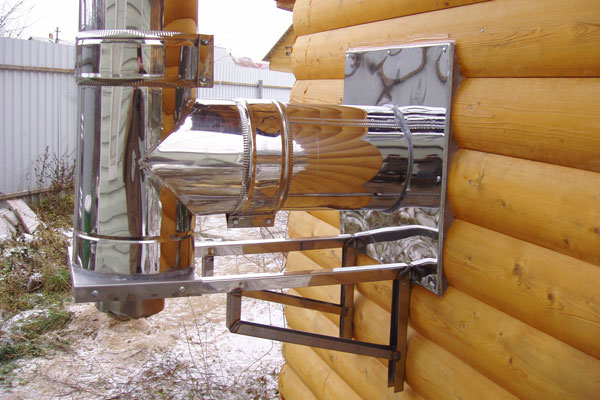
The flue gas temperature at the outlet of the TT boiler can reach 600 degrees Celsius. Therefore, for use in conjunction with a ZOTA solid fuel heating boiler, a steel and ceramic chimney is quite suitable. The use of chimneys made of glass and plastic is not allowed, as these materials are designed for significantly lower gas temperatures.
Separately, it is worth noting the classic brick chimney. The aggressive environment that occurs inside such a structure quickly renders it unusable. That is why they give way to more modern devices.
Most often, stainless steel is used as the material for the manufacture of the chimney. The use of steel gives such a device a number of undeniable advantages:
- has a low weight compared to brick;
- easy to install and install;
- does not require the construction of a foundation;
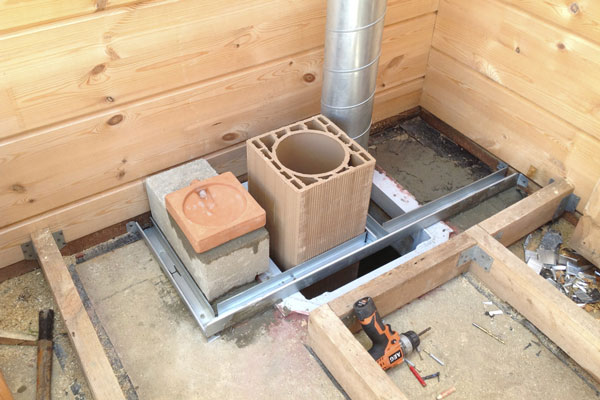
Chimneys made of stainless steel according to the type of construction are divided into the following types:
Single wall
Such chimneys are an ordinary steel pipe. The advantage of this design is its low cost. The main disadvantage is the formation of condensate on the inner surface and, as a result, its freezing at sub-zero temperatures.
Double-walled (or double-walled)
The device of such a chimney is a “pipe in pipe” design.A smaller diameter pipe is placed inside the main pipe, and the space between them is filled with heat-insulating material. The advantage of this design is the presence of thermal insulation that protects the chimney from the formation of condensate, and the disadvantage is that the price of such devices is much higher.
Recently, the design of the chimney in the form of a sandwich pipe has gained particular popularity. This design is a chimney assembled from separate pipes of a meter length, the joints of which are equipped with heat-insulating material.
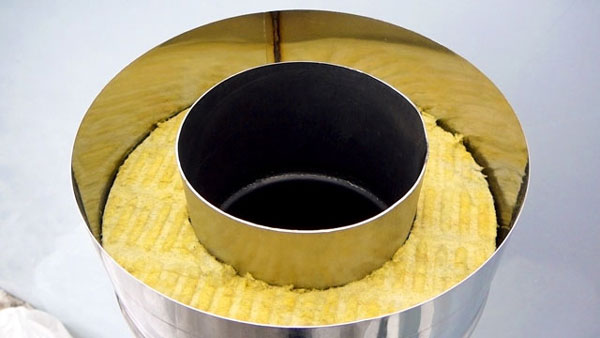
Special requirements are imposed on the wall thickness of the steel chimney. When used in conjunction with TT boilers, the wall thickness of the chimney must be 1mm or more.
Ceramic chimneys are also used to remove combustion products from a solid fuel boiler. Like steel, they are resistant to high temperatures and aggressive environments. The thickness of their walls is much larger (1.5 cm), and therefore they are much heavier and require installation on the foundation. Also, ceramic chimneys must be strictly vertical. The presence of various bends is excluded. This feature in some cases makes it impossible to install and install such a chimney.
Advantages and disadvantages
Boilers with a fire-tube design have the following advantages:
- high efficiency, reaching 92-93% due to efficient heat distribution and complete power take-off from the generated heat flow during fuel combustion;
- no heating of the outer surface of the case due to the use of a water jacket;
- high heat capacity of the boiler and minimal heating inertia during operation;
- stable temperature parameters due to complete control of the fuel combustion process;
- safety during operation: the risk of explosion due to high pressure increase is minimal;
- the possibility of making modifications in order to change the technical characteristics;
- simplicity of design, allowing maintenance and repairs without the involvement of specialists;
- compact dimensions compared to other types of boilers with similar characteristics;
- reliability and durability due to the use of heat-resistant steel and the minimum number of welds;
- the possibility of using for heating objects operated in harsh climatic conditions;
- average service life from 20 to 50 years;
- excellent maintainability;
- availability of structures for the use of various types of fuel.

The disadvantages of the fire-tube design include:
- in the case of using hard water, uneven scale forms on the internal surfaces, which can be removed only after disassembly, which is very time consuming;
- high water consumption;
- the appearance of stagnant zones of the coolant due to the low speed of its circulation;
- the need for constant monitoring of the condition and periodic maintenance, to prevent emergencies;
- the difficulty of cleaning the passages for the removal of combustion products from the combustion chamber;
- the presence of unheated areas inside the heat exchangers due to the low circulation rate of the heat flow.
What is the difference between gas and water tube steam boilers
The principle of generating steam from water can be implemented in two ways, the difference is as follows:
- Gas-tube boilers. Water is placed in a separate container, from which it enters the heating zone through special pipes. Heating occurs due to the upward movement of heated gas.
- Water tube boilers. In this design option, the heated gas moves through pipes that are located inside the water tank. The working medium is placed in drums, which can be located in any part of the boiler itself.
The water-tube model of the boiler is smaller in size, and also cannot boast of high performance.Gas-pipe options are ways to give pressure up to 1 MPa, and the heat-generating capacity reaches 360 kW. Such parameters are possible due to the increased size of the pipes, but the cost of a steam boiler of this type will be much higher. Water-tube options are characterized by increased power, as they use pipes with thin walls. Heating is faster, and the device itself is not afraid of significant loads.
Additional elements of boilers
The steam boiler has a strictly defined function, and the main task is solved by the pipeline and containers with the working medium. However, the modern version of such a device is complemented by a whole range of various components that are designed to increase its effectiveness:
Superheater
For some installations, it is important to heat the steam to maximum performance, this part is used for this. The presence of a superheater reduces fuel consumption and increases its efficiency, since heating already affects the finished steam.
Separator
This part serves to separate moisture from steam in order to obtain a dry coolant.
Steam accumulator. A control device that is necessary to maintain a constant pressure in the system.
preparatory device. To protect the pipeline from deformation and destruction, water must first be prepared before being supplied to the heating zone. The composition of the water should contain a minimum amount of oxygen and minerals.
Control devices
In addition to the components that solve work tasks, the design of the steam boiler includes parts that perform a regulatory function. One of the main characteristics for the normal operation of the steam boiler is the constant monitoring of the water level in the drum. To do this, a limit level indicator inside the steam boiler is used, which collects data on the change in the position of the goods when water changes into steam. Another device for a similar purpose is a level column. This sensor uses the electrical conductivity of the water and monitors the water level.
The simplest device for monitoring the water level is a gauge glass. The component is built into the boiler body and works on the principle of communicating vessels.
In addition to the water level, it is important to monitor the readings of thermometers and pressure gauges in order to avoid emergency breakdowns.
Steam generators
A steam generator is a type of steam boiler that is characterized by increased productivity. A device of this type is used to produce superheated steam in industrial plants and is large in size. In addition to the standard set of parts, several superheaters are placed inside such a device, so the steam is subjected to intense heating.
Similar systems are used in nuclear power plants, where hot steam converts atomic energy into electricity. The process of heating water in the reactor can be implemented in two ways:
- Placement outside the reactor vessel. Water washes the reactor vessel, contributing to its cooling and taking away thermal energy. A separate circuit serves to remove the resulting steam, and the steam generator plays the role of a heat exchanger.
- Internal pipeline. The pipes with the working medium can pass inside the reactor, which acts as a combustion chamber, and the steam is supplied to the electric generator.
Conclusion
Steam boilers are one of the achievements of modern engineering, and such equipment is used both in everyday life and on an industrial scale. Modern heating systems, mechanical platforms and various manufacturing equipment use steam for various purposes, but to generate such a resource you will need an efficient steam boiler.
To date, the developers of steam systems have reached the heights of their skills, and the devices themselves are equally successful both in the industrial sector and in everyday life.
Features and Benefits
Fire-tube boilers are widely used in various fields due to the following characteristics:
- The presence of a simple design and ease of use with it.
- Availability of several types of equipment, including hot water and steam.
- The presence of areas with a high rate of heat stress.
- Optimum safety level for fire-tube boilers.
- High power output with compact dimensions.
- The presence of heating equipment to ensure automatic operation. This is achieved through the use of additional devices: pressure gauge, air vent, thermometer, water pressure sensor, etc.
- Stable operation of the burner on the fire tubes of the boiler without the problem of flame pulsation.
- The use of steel for the heat exchanger allows steam and hot water fire tube boilers to be protected from corrosion and temperature extremes.
Despite some disagreements, this type of heating equipment, both steam and hot water type, is widely used in European countries in the industrial sector.
Among the factors that affect this indicator, the following can be distinguished:
- The large volume of water used in fire-tube boilers makes it possible to maintain a stable outlet temperature.
- The low rate of hydraulic resistance of steam or hot water fire-tube units directly affects the reduction in operating costs.
- The fire tube of the boiler ensures almost 100% combustion of fuel, which ensures a high efficiency rate, reaching over 90%.
- The high level of thermal power of steam or water-heating equipment makes it possible to reduce the amount of heat loss from the structure in the presence of adverse climatic conditions.
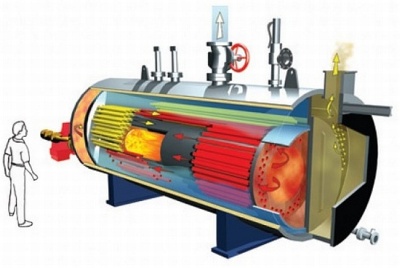
As for the disadvantages of fire tube units, this can be attributed to their relatively high explosiveness, which is explained by the design features of the unit, in particular fire tubes. However, subject to all the rules and regulations for the use of equipment, steam and hot water fire-tube boilers will be absolutely safe and reliable in operation.
Water tube and once-through steam generator
Fire tube boiler and water tube boiler are different from each other. Water tube - the direct opposite of the fire tube unit. By the way these solutions work, they distinguish water-tube and direct-flow.
The steam drum boiler has pipes in the design of the combustion screen connected to the drums of an average diameter. Water or other coolant circulates several times through unheated pipes, improving thermal conductivity. Drums are tanks inside which water and steam are separated. The circulation in the drums can be either forced or natural.
There is no drum in the once-through boiler. This is nothing more than a coil located inside the firebox. The coolant is pumped into the coil using a pump. The water in the water tube boiler flows through the evaporator tubes and turns into steam. In the transition zone, the process of steam formation ends, and then it is fed into the superheater.
These boilers are an open hydraulic system and can operate at pressures greater or less than the specified pressure.
Among the main advantages are high heating rate, excellent circulation, efficiency higher than that of fire-tube boilers, protection against overheating, the ability to use various types of fuel, compact dimensions.
Installation and connection of the chimney pipe
The service life of the solid fuel boiler and the safety of its owner depend on how correctly and safely the chimney is installed. It is better to entrust the installation and installation of a chimney to professionals. Specialists will be able to perform these works in accordance with the following rules and regulations:
- the chimney system must completely remove all combustion products;
- the cross section of the chimney must be greater than or equal to the cross section of the outlet pipe of the solid fuel boiler;
- the chimney must be made of anti-corrosion steel with a thickness of more than 1 mm;
- to clean soot at the base of the chimney, it is necessary to organize a special pocket;
- no more than three turns of the pipe are allowed;
- the height of the pipe is not less than 5 m, and also not less than the minimum allowable for this model of solid fuel boiler;
There are also a number of requirements for the location of the chimney on the roof:
- The top end should rise less than 50cm above the flat roof, or 50cm above the parapet if the parapet is less than 1.5 meters away.
- Not lower than the roof ridge when located less than 3 meters from it;
- If the height above the roof level is more than 1.8 m, it is necessary to fix it with braces;
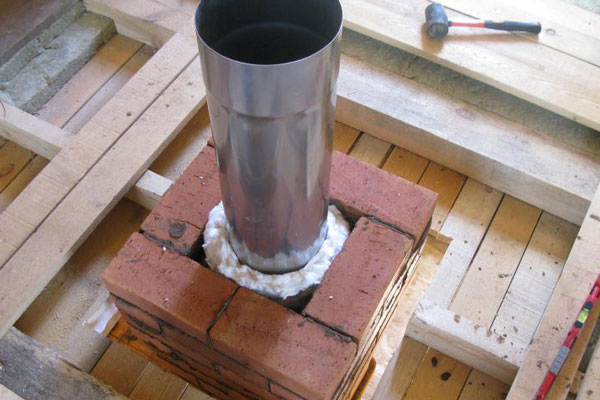
Installation is carried out according to the scheme from the bottom up, i.e. from the solid fuel boiler to the roof. There are general requirements for the installation of such systems and they are regulated by SNiP-91. Here are the basic rules that must be strictly observed:
- When assembling sections of a chimney sandwich, each inner pipe should be inserted inside the previous one, and each outer pipe, on the contrary, on top of the previous one. This assembly method is called "by condensate".
- tyki sections must be fastened with clamps.
- Fastening to walls and other building structures is carried out using brackets.
- To ensure fire safety requirements, it is necessary to avoid contact of the chimney with gas pipes and electrical wiring. It is also necessary to avoid contact with structural elements (roofing, ceilings, lathing, etc.) and keep them at a distance of 150mm for insulated pipes and 300mm for non-insulated pipes.
- The horizontal section of the pipe connecting to a long-burning solid fuel boiler with a water circuit must be inclined towards the boiler. The angle of inclination is approximately 2cm per meter of connecting pipe.
- Care must be taken to ensure that the knee joints do not fall into the ceilings between floors.
- In order to avoid condensation of combustion products, it is necessary to equip the area passing through unheated rooms with additional insulation.
- A tee with a condensate drain system is installed at the bottom of the chimney.
The use of sectional systems requires careful and safe operation. Here are some restrictions that must be strictly observed:
- It is forbidden to use liquid fuel to kindle a solid fuel boiler;
- It is strictly forbidden to use the chimney to dry clothes or shoes;
- When cleaning the chimney, it is not recommended to burn out the soot;
- It is forbidden to use water to extinguish solid fuels in the boiler furnace.
For more information on how to choose the right chimney for a solid fuel boiler, see the video:
In conclusion, I would like to note once again that it is better to entrust the calculation, installation, installation of a chimney and its connection to a solid fuel boiler to professionals. Your life and health, as well as the life and health of your loved ones, depend on the correct and safe connection. Remember this!
Features and Benefits
- 21 sizes ranging from 80 to 6,700 kW
- Continuous power range in 1 kW increments
- The maximum water temperature at the outlet of the boiler is 110 °С
- Maximum working water pressure 0.5 MPa (5 bar)
- Designed to run on natural gas or light oil
- Power control range 30 - 100%
- Certified to the requirements of TR CU
- Maximum adapted for use in Russian heating networks
- Warranty 2 years
- Service life of at least 15 years
- Production certified according to ISO 9001:2008
DUOTHERM is a two-pass hot water fire tube boiler with a reversible furnace. For models 80 - 500 kW, the flame tube is structurally shifted down, the fire tubes are located in the upper segment above the flame tube.The entire combustion chamber is supported by fully water-washed anchors.
For models 501 - 6700 kW, the flame tube is located centrally, the fire tubes are located around the flame tube. The combustion chamber is supported by water-washed anchors.
To intensify the heat transfer process and obtain the required efficiency, turbulators are installed in the fire tubes.
The body of the boiler is insulated and sheathed with a decorative sheet.
From the front of the boiler there is a rotary chamber, on which the burner is installed. The design of the chamber allows it to be opened to either side of the boiler.
To ensure the gas tightness of the connection of the rotary chamber and the boiler body, a double tooth-groove connection with a sealing cord is used. To ensure the standard temperature of the outer surface, the rotary chamber is insulated with high-temperature-resistant heat-insulating materials using modern technologies.
A gas box is installed from the rear of the boiler. For the possibility of inspection and, if necessary, cleaning, a rectangular hatch is provided on the gas box.
Connection pipes to the supply and return lines are located on the top of the boiler, pipes are also provided for the installation of safety valves.
In the lower part of the boiler, a purge and drainage pipe is provided.
The quality of network, make-up water and the operating mode must comply with the requirements set forth in the boiler operation manual, as well as the requirements of the current regulatory and technical documents for the water-chemical regimes of boilers of this type.
To complete the boilers, gas, liquid fuel or combined burners of domestic and foreign manufacturers can be used, having the appropriate technical characteristics, as well as the necessary permits for the possibility of use on the territory of the Russian Federation.
Documentation
Scope of fire-tube steam boilers
Fire tube steam boilers are widely used in modern life. And most often they are used in the field of housing and communal services, as well as in production, where there is a need for steam. For example, such equipment can be seen in boiler rooms serving:
- residential buildings and complexes;
- commercial and administrative premises;
- production shops;
- medical and educational institutions;
- other objects requiring an efficient and inexpensive heat source.
In general, it can be noted that equipment of this type is used in any place where the demand for steam is constant and uniform.
Carrying out technical calculations of fire-tube units
Before installing a fire-tube boiler, specialists carry out a lot of technical calculations based on the intended purpose, equipment model, fuel used, climatic and other operating conditions, and other parameters.
The main types of technical calculations are:
-
calculation of service life under specific conditions of use
(water quality, duration of the heating season, and so on); -
calculation of fuel consumption and volume of combustion products
. Each type of fuel has its own combustion coefficients, and depending on the capacity of the installation, the indicators of consumption and heat loss may be different; -
boiler heat balance
- establishment of equality between the heat received during combustion and the sum of the used and lost heat; - calculation of the combustion chamber, geometric parameters, diameter, length and volume of the furnace;
- other.
Possibility of converting equipment to gas
Most often, steam or water-heating fire-tube devices are used to supply hot water to residential buildings and enterprises. Quite often this type of equipment is used in industrial enterprises and organizations.At the same time, in order to increase efficiency, fire-tube boilers often switch to gas.
To implement this option, additional components must be installed inside the equipment. Mandatory elements are low pressure gas burners, which can be replaced by a special type of medium pressure injection type burners. You will also need to remove the grate. Its main purpose in fire-tube boilers is the combustion of solid fuels, however, since this is not necessary in the presence of gas, it can be removed.
As for the reasonableness of transferring a fire-tube boiler to gas, there is no unequivocal opinion among professionals. Some consider this option quite acceptable and reliable, while others suggest replacing it with alternative units. In any case, with properly drunken work, the equipment will work reliably and with optimal technical performance.
The only drawback of such manipulations is that after switching to gas, fire-tube boilers may experience heating of the burner nozzle, which is accompanied by combustion pulsation, soft pops, crackling and flame ejection.
Since the conversion of a fire-tube boiler to gas is a complex process that requires knowledge and certain skills, and given that possible errors in operation can lead to the creation of an explosive situation, all work must be performed by specialists with appropriate qualifications. Unauthorized intervention can create a dangerous situation for the owner of the equipment and his relatives.
Fire tube boilers are widely used in various fields. They have a good indicator of power, are easy to install, operate and maintain, and are also easy to repair. A variety of models allows you to choose the option for any room and for a variety of conditions. The main thing is to choose a quality option and strictly follow the instructions for its operation.
The fire tube boiler was invented in the 19th century to increase the steam output of conventional cylindrical boilers without changing their dimensions by developing internal heating surfaces. In our time, fire-tube boilers have not lost their relevance.
A fire tube boiler has flame tubes that run inside the water space of the boiler. Everyone knows that fire-tube heating boilers are not difficult to manufacture, respectively, and the price of such boilers is minimal.
